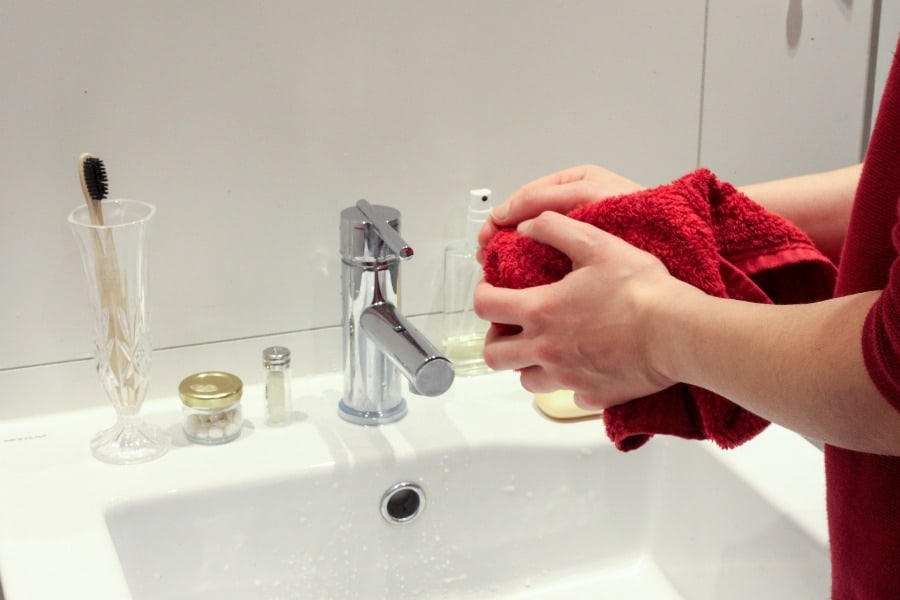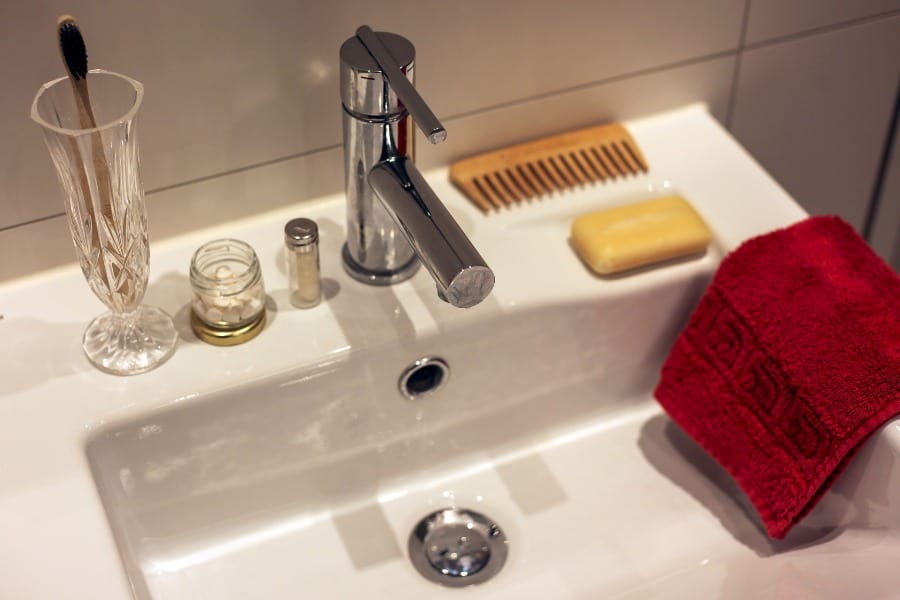As an Amazon Associate we earn from qualifying purchases.
A study reveals that a bathroom sink is one of the top 5 contaminated areas in the home. Germs reside on the handles of the faucet and inner walls of the basin, which can breed in the overflow hole of the sink and impart a foul smell. Moreover, the bacteria can multiply exponentially if not treated in time.
Use the following tips in this multiple method guide on how to clean a bathroom sink overflow hole.
How To Clean A Bathroom Sink Overflow Hole
To prevent the growth of contaminants in your clean sink overflow hole, start by gathering the following tools:

Things You Need
- A kettle
- Boiling water
- Snake tool
- Alink sink overflow cleaning brush
- Plunger
- White vinegar
- Baking soda
- Bio-enzyme cleaner
- Drain cleaner
- Silicone funnel
Method #1: Use a Rubber Plunger
A rubber plunger is the first choice of most to clean blockages. A plunger creates a suction on the rims to the surface it has been attached. This helps in creating a pseudo vacuum force that helps to clean the inside of the sink. If you are all set to clean your kitchen or any other sink overflow, then do the following:
- Fill the overflow hole halfway with hot water.
- Use a flat bottom plunger instead of a regular plunger to create suction.
- Stick the plunger across the rim of the overflow hole with force.
- Create suction by moving the handle of the plunger in a back and forth direction.
- Work the plunger for 5-10 minutes.
- Remove the plunger and drain down the water from the overflow hole.
Method #2: Use Hot Water
If you are looking to unclog and clean the sink overflow, then this method will surely help you out. A very simple way to unclog and clean the overflow and remove the stinking smell from the sink is to use hot boiling water.
By pouring two quarts of boiling water into the overflow hole, the stagnant water in the drain would flush out. Moreover, molds and bacteria won’t be able to sustain such a high temperature. Thus, there won’t be any bad smells coming from the sink.
If you didn’t get rid of the smell, repeat as needed.
—
Warning
Don’t pour the boiling water directly into the overflow hole. Use a silicone funnel or mold that can withstand the high temperature of the water. Also, be cautious while handling the boiling water as it can burn your hands. Avoid pouring water without the funnel, as it will lead to a crack in the sink.
—
Method #3: Use a Sink Overflow Cleaning Brush
Today the market is flooded with various supplements that have made household chores easier. For example, the Alink Sink Overflow brush comes with many spiral bristles for cleaning and unclogging the overflow drainpipe.
This sink overflow brush is flexible, enabling it to reach the difficult corners of the overflow drain. Thus, all you need to do is to put this brush in the overflow hole and slide it in a back and forth direction.

After unclogging the overflow hole, run hot water through the clean sink overflow. Use a silicone mold to pour hot water that will help to flush out the dirt into the drain.
Method #4: Use a Bio-Enzyme Cleaner
Bio-enzymes are made with natural ingredients and thus are used for many purposes. Moreover, they are easy on your pocket and don’t negatively impact the environment. This reason makes them the eco-friendly alternative to the chemical cleaning method.
Bio-enzyme cleaner not only unclogs the overflow hole but also kills the bacteria and molds that live in the moist overflow hole of the sink. They either come in powder or liquid form.
To clean your sink overflow hole, grab 50ml of powdered bio-enzyme cleaner and mix it in 100ml of lukewarm or hot water. You can also use the liquid bio-enzyme cleaner, mix 50 ml of the solution in 100ml of hot or warm water. Leave the solution be for 30 minutes.
Pour this solution into the overflow hole and let it sit overnight. Rinse off the solution the following day with hot boiling water.
Method #5: Use Vinegar with Baking Soda
An unclean overflow hole can impart a bad odor that can make you fall ill. In such cases, just using the hot water may not be enough. Therefore, it is suggested to use two ingredients to remove the nasty smell.
For this, you don’t have to run to a supermarket but to your kitchen.
- Just grab one cup and a half of baking soda and ½ cup of distilled white vinegar from your drawers.
- Put a snake tool to unclog the overflow hole, then add ½ cup of baking soda and vinegar using a funnel or silicone mold and let the solution sit for 15-20 minutes.
- Flush the solution with hot or boiling water. Beware while draining boiling water through your porcelain sink as it may fall apart. Therefore, rather than pouring all of the water at once, pour it in parts.
For best results, do this twice.
Method #6: Use Drain Cleaner
Unlike Bio-enzyme cleaners, drain cleaners are not eco-friendly and have a strong chemical smell. But, they are more effective in terms of cleaning. Only a small quantity of drain cleaner is enough to make your sink clean.
To clean your overflow hole using a drain cleaner:
- Mix a 50g sachet of pipe cleaner in a mug full of tap water and flush the overflow hole with the solution.
- Finally, run hot boiling water down the line to remove the settled debris across the pipeline of the hole.
—
Tip
Since the smell of the drain cleaner is quite strong, it is advised to use a drain cleaner that has added floral or fruity fragrance for a better odor.
—

Method #7: Call a Plumber
If the problem continues to exist, it could be due to some other issues in the pipeline that cannot be fixed manually. The drain mechanism is quite complex, and sometimes only the professionals know what’s wrong.
A professional understands the root of the problem and thus, can guide you for your better. Apart from clogged drains, there could be other reasons behind the stinky smell:
- Sometimes small pests get stuck in the drain pipeline; due to lack of movement, they succumb and impart an unpleasant, terrible smell across the pipeline.
- It is also possible that the sewer connection is leaking, and therefore a foul smell is coming.
Hence, try contacting a professional or a plumber who can help with your drainage problem.
Frequently Asked Questions
Is it Necessary to Have an Overflow Hole in the Bathroom Sink?
No. An overflow hole in the sink is not mandatory. There are sinks available in the market that don’t have an overflow hole and don’t make a big difference in the user experience.
Does a Sink With an Overflow Hole Drain Slower than One Without it?
It depends on what type of sink you have. If you have a lav basin, then it might drain slower. While there are sink with a pop-up drain that can drain faster due to its design and might not need one
Conclusion
As per a study, about 13000 bacteria live on the tap of the bathroom basin. These bacteria are strong enough to make you fall ill. Plugholes and overflow holes are usually warm and moist that allow bacteria to grow.
It is quite shocking to know that the toilets have near or fewer bacteria than a bathroom sink. According to the International Scientific Forum on home hygiene, a species of bacteria, Pseudomonas aeruginosa, can breed in these holes.
This bacterium breeds rapidly and affects the urinary tract, and can cause infections. Therefore, cleaning your washbasin once in a while should be a mandatory practice to avoid such harmful pathogens from multiplying.
By following this multiple method guide, you can keep your bathroom sink hygienic and thus, can safeguard the health of your family.
